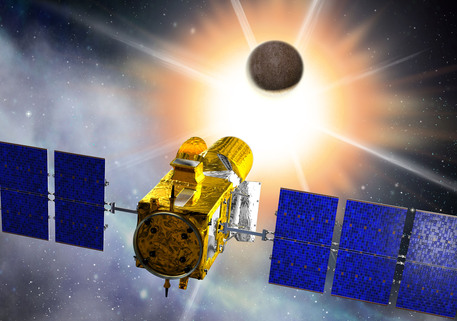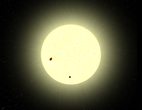Satellite Corot finds first rocky Exoplanet
Rocky Super-Earth found
An international team of scientists found an extraordinarily small exoplanet just 400 light years away from earth. Astronomers call planets outside of our solar system exoplanets. The scientists rely on data from the French Satellite Corot (short for “Convection, Rotation and Planetary Transits) orbiting the earth. Corot has been supporting the search for distant worlds since December 2006.
 © CNES/D. Ducros |
Artist's impression of the exoplanet hunter Corot in action
The rocky planet with the name Carot-Exo-7b is the smallest extrasolar planet orbiting around a main sequence star from all 337 exoplanets categorized so far. Most planets discovered outside of our solar system are gas giants, so called “hot-Jupiters”.
However the latest discovery is out of rock and just twice the size of the earth. This rarely found example is called a Super-Earth. Corot-Exo-7b orbits its central star in just 20 hours. Since the planet is so close, the temperature is thought to exceed 1800 Degrees Fahrenheit on the surface.
“So far we can only guess the mass of the planet is less than 10 times the mass of the earth”, says Heike Rauer who heads the Corot project at the German Aerospace Center. Data of the radial velocity of the central star still needs to be analyzed. As a result also the density of the planet is still unknown, which will eventually reveal its chemical composition.
Rauer calls this a real sensation and is satisfied that the high expectations of Corot are completely fulfilled. The German Aerospace Center has developed the software for the satellite and is also involved with the analysis of the data.
In follow up observations of the central star of Corot-Exo-7b the scientists found hints for another planet a little further away. It seems to orbit in eight days and weigh about 14 times as much as the earth. These measurements still have to be confirmed, but one thing is for certain: There is still much to be expected from Corot.
Thorsten Dambeck is a physicist and science writer in Germany. Translation: Raphael Steinbach.
However the latest discovery is out of rock and just twice the size of the earth. This rarely found example is called a Super-Earth. Corot-Exo-7b orbits its central star in just 20 hours. Since the planet is so close, the temperature is thought to exceed 1800 Degrees Fahrenheit on the surface.
“So far we can only guess the mass of the planet is less than 10 times the mass of the earth”, says Heike Rauer who heads the Corot project at the German Aerospace Center. Data of the radial velocity of the central star still needs to be analyzed. As a result also the density of the planet is still unknown, which will eventually reveal its chemical composition.
Rauer calls this a real sensation and is satisfied that the high expectations of Corot are completely fulfilled. The German Aerospace Center has developed the software for the satellite and is also involved with the analysis of the data.
In follow up observations of the central star of Corot-Exo-7b the scientists found hints for another planet a little further away. It seems to orbit in eight days and weigh about 14 times as much as the earth. These measurements still have to be confirmed, but one thing is for certain: There is still much to be expected from Corot.
Thorsten Dambeck is a physicist and science writer in Germany. Translation: Raphael Steinbach.
Satellite Corot finds first rocky Exoplanet
Rocky Super-Earth found
An international team of scientists found an extraordinarily small exoplanet just 400 light years away from earth. Astronomers call planets outside of our solar system exoplanets. The scientists rely on data from the French Satellite Corot (short for “Convection, Rotation and Planetary Transits) orbiting the earth. Corot has been supporting the search for distant worlds since December 2006.
 © CNES/D. Ducros |
Artist's impression of the exoplanet hunter Corot in action
The rocky planet with the name Carot-Exo-7b is the smallest extrasolar planet orbiting around a main sequence star from all 337 exoplanets categorized so far. Most planets discovered outside of our solar system are gas giants, so called “hot-Jupiters”.
However the latest discovery is out of rock and just twice the size of the earth. This rarely found example is called a Super-Earth. Corot-Exo-7b orbits its central star in just 20 hours. Since the planet is so close, the temperature is thought to exceed 1800 Degrees Fahrenheit on the surface.
“So far we can only guess the mass of the planet is less than 10 times the mass of the earth”, says Heike Rauer who heads the Corot project at the German Aerospace Center. Data of the radial velocity of the central star still needs to be analyzed. As a result also the density of the planet is still unknown, which will eventually reveal its chemical composition.
Rauer calls this a real sensation and is satisfied that the high expectations of Corot are completely fulfilled. The German Aerospace Center has developed the software for the satellite and is also involved with the analysis of the data.
In follow up observations of the central star of Corot-Exo-7b the scientists found hints for another planet a little further away. It seems to orbit in eight days and weigh about 14 times as much as the earth. These measurements still have to be confirmed, but one thing is for certain: There is still much to be expected from Corot.
Thorsten Dambeck is a physicist and science writer in Germany. Translation: Raphael Steinbach.
However the latest discovery is out of rock and just twice the size of the earth. This rarely found example is called a Super-Earth. Corot-Exo-7b orbits its central star in just 20 hours. Since the planet is so close, the temperature is thought to exceed 1800 Degrees Fahrenheit on the surface.
“So far we can only guess the mass of the planet is less than 10 times the mass of the earth”, says Heike Rauer who heads the Corot project at the German Aerospace Center. Data of the radial velocity of the central star still needs to be analyzed. As a result also the density of the planet is still unknown, which will eventually reveal its chemical composition.
Rauer calls this a real sensation and is satisfied that the high expectations of Corot are completely fulfilled. The German Aerospace Center has developed the software for the satellite and is also involved with the analysis of the data.
In follow up observations of the central star of Corot-Exo-7b the scientists found hints for another planet a little further away. It seems to orbit in eight days and weigh about 14 times as much as the earth. These measurements still have to be confirmed, but one thing is for certain: There is still much to be expected from Corot.
Thorsten Dambeck is a physicist and science writer in Germany. Translation: Raphael Steinbach.








